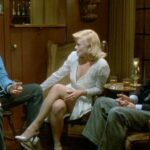Who Should Own What in the Digital Age?
Jeff VanderMeer on Why You Should Care About the End of Black Clock Magazine
This year Black Clock literary magazine, a fixture at CalArts, published its last issue much to my dismay and disappointment. Issue #21 went out with a “bang-whimper,” a title in honor of a theme of apocalypses, great and small. The magazine had meant a great deal to me, and I thought it deserved a proper send-off in the form of an appreciation.
But working on that appreciation began to deepen into something else, because as I reached out for comments for my “puff piece” I discovered contradictions about how and why Black Clock had folded—and, weirdly, the magazine’s website and Facebook page had been deleted post haste. No one had a good answer for that action, either.
Should anyone care about Black Clock folding, or why it in effect has been erased from the online history of literary magazines? I don’t know the answer. All I can do is tell you what I learned and why Black Clock may have deserved better.
An Eclectic, Unique Magazine
For more than a decade, alongside managing editor and writer Bruce Bauman, the great American novelist Steve Erickson lent his time, energy, and even the title of one of his novels, Tours of the Black Clock, to a lively and unique literary journal that published an eclectic group of established authors and multiple major award winners alongside plenty of new talent.
Black Clock published, among others, Samuel R. Delany, Jonathan Lethem, Rick Moody, Grace Krilanovich, David Ulin, Aimee Bender, Don DeLillo, Nalo Hopkinson, Mark Danielewski, Miranda July, Heidi Julavits, Joanna Scott, Susan Straight, Lydia Davis, Ben Marcus, Maggie Nelson, Richard Powers, William Vollmann, and David Foster Wallace. Other highlights include two novels first excerpted in its pages that later won the National Book Award and several stories that were anthologized in year’s best anthologies. The magazine also published the Delany short story that became his novel Through the Valley of the Nest of Spiders. Each issue had a different theme, and it produced especially powerful work around national elections. Black Clock also had a distinctive look-and-feel, courtesy of innovative art directors Gail Swanlund and Ophelia Chong. As someone published in Black Clock, I liked how with every new issue was different and yet somehow existentially Black Clockian.
“Being published by an art school, the magazine kind of had an obligation to have an aesthetic point of view in harmony with its literary merit,” production editor Anne-Marie Kinney told me. “Each issue was a cohesive piece of art. The content and imagery worked together to form a whole experience.” (You can view pages from the last issue, designed by Chong, on her blog.)
The magazine published what I felt was my best and most out-there work, including an alternate-history 9/11 piece and an excerpt from my novel Borne (now slated for publication by Farrar, Straus and Giroux in 2017). I also appreciated that Erickson and the entire editorial staff eschewed the usual binary distinctions, the artificial divisions that often locate sympathetic works on opposite sides of the “genre” and “literary” divide. It can be difficult for writers perceived as writing fantasy/science fiction to place work with literary magazines. But Black Clock didn’t operate from that limiting perspective; they saw a different landscape and a different horizon. I never knew what I would discover within its pages, only that it would be mind-blowing.
As Jonathan Lethem told me, “To a greater degree than nearly any other literary journal I’d ever been involved in—more than Fence, more than Crank, more even than McSweeney’s, apart from the first few issues—Black Clock arrived with the air of a self-contained literary universe. You recognized the writers’ names, or you didn’t, but the whole thing felt like a glimpse of an alternate universe, with its own force and attraction, its own imperatives and field of reference, and completely outside the sphere of any received hierarchies or traditions. And it stayed that way to the end. It was also just relentlessly fucking beautiful to hold and to behold.”
Rick Moody pointed to its conceptual and editorial rigor as unique. “There was always an interesting idea… And it was extremely well curated… If I could get Steve [Erickson] to edit everything I write from now on, I would.”
Moody recalled a particular time:
Steve let me write about the presidential elections in 2008 and 2012 (and I wish he were publishing me in 2016, too), and among my scurrilities along these lines was a lengthy meditation on the possibility that Newt Gingrich was (is) a diaper fetishist. I must say, this was a rather vehement and extended passage, and in the old days before the notion of the public figure was codified, it would have been wholly libelous. Well, Steve, to his credit, actually flew me out to LA at some point to read from the election diary, and even encouraged me to read the diaper fetishist passage at this public event, which I did. Only to find that it was even more violently provocative out loud than it was on the page. When I was done reading, Steve got up and said something like: “Well, ladies and gentlemen, that’s how we do it at Black Clock.” I think it’s conceivable I will never again be as unconditionally supported in my career, alas.
“The writing in it was so different from the traditional good writing I feel like ends up in most literary magazines,” former assistant editor Jessica Felleman, now an agent and writer, recalled. “By good I don’t mean BC writers aren’t good (they’re rock stars) or that other literary magazines aren’t good in comparison; I mean conventionally what you expect from good. In BC there was always something to most of the pieces that felt scrappy, like you could taste the author’s sweat and tears, like you could see the writer behind it. Now maybe that’s because I literally could see the writers, but there was this attitude like, we didn’t want perfection, we wanted reaction instead—conversation instead of golf-claps. Steve and Bruce weren’t aiming to please anyone. And that was cool.”
Discovering Writers
One measure of a good literary magazine is the kind of curation that draws on established writers but also can identify and champion new writers with unique voices. Both contributors and staff were eager to share who they had first read because of Black Clock.
For Lethem it was “Anthony Miller and Grace Krilanovich and Ben Ehrenreich.”
For Kinney, “Working on the magazine initiated my fandom of local authors like Susan Straight and Diana Wagman. I was introduced to the elegance of Jay Neugeboren, the heady otherworldliness of Nalo Hopkinson… I could go on. Having been the production editor (which largely meant being head copy editor), I have a weird relationship with the issues I worked on. I read each story so closely, many times over, almost to the point of memorization. Lines come back to me out of nowhere, images I’ll never forget. There’s a story by Amanda Ruud in issue 19 called ‘Vernix Caseosa’ that I still think about with almost creepy frequency.”
Felleman recalled that she first read “Aimee Bender in BC, and then I got to copy-edit her in one issue—that was a bit surreal. I feel so lucky and thankful that Black Clock let interns get involved and communicate and work with authors. Francesca Lia Block’s writing was one of the reasons I’d originally wanted to move to LA. I got to work with Janet Fitch too. The greatest thing was that they were all so down to earth… They showed me that being a writer was possible.”
Given the commitment to themes, Felleman remembered favorite issues as much as favorite writers. Her own favorite is “Issue #18 where there are chapters that didn’t make it into the final cut of the novels they were written for. As a fledgling writer, it was such a relief to learn that published books never started out the way they looked at the end. This issue makes me kind of giddy, like I was peeking into the underwear drawer or the deleted internet browser history of the book.”
Scott couldn’t quite pin down favorite issues, but repeated a recurring theme in answers: “Each issue was completely surprising in its variations, but the rebel spirit of the magazine was reassuringly consistent. As a reader, I could expect to see in each piece a supple handling of language and form. I liked the way themes created a unity among diverse contributors. I liked the way Steve would light up writers with a bright spark of an idea to explore. The hard copies were always visually striking.”
Working on the Magazine
The backstory of a magazine’s daily operations may not seem like the most exciting topic, but as someone who has served as editor or publisher for more than one magazine, I can tell you that tale forms a kinetic secret history of the passion, connectivity, and wider sense of book culture hardwired into the best collaborative creative projects. You don’t just learn how to edit or how to select stories—you have conversations, communication, and a literary discourse behind the scenes that shapes you.
Everyone who leaves such a space carries forward with them not just the memory of the experience, but the imagination, work ethic, and ideas. In that respect, no one I contacted had anything but praise for how Black Clock was run.
“The staff, [including] Steve [and] Bruce were so confident in us from the start and so honest about how hard it is to run a literary magazine,” Felleman told me. “I learned so much about what it means to be an editor, to be caring for another person’s piece of writing before it goes out into the world. It opened up the literary community outside of being a reader and a writer, introduced me to other magazines and different kinds of writers. Black Clock grounded the literary world for me, made it accessible and not so scary.”
“What I loved about working on Black Clock was how much everybody cared about the finished product,” Kinney said. “It all stemmed from Steve’s style as an editor, the balance of having a very distinct vision while also giving authors a long leash. Steve knew what he wanted for each issue, but he instilled trust in the authors and the work to make that vision happen on each author’s own terms….”
Lethem cited Erickson as “one of my major heroes in my twenties, when I was still working in bookstores in Berkeley and groping my way into a style partly by aping him in books like Amnesia Moon. So, getting to publish with him, and then to make him a friend and colleague in the same span of time, was a definite thrill. As an editor he’s the ultimate writer’s advocate, taking the assumption that the work has a mainspring in it which might be delicate and therefore advancing all editorial suggestions with the greatest caution and reverence. And he instilled an ethos in his staff—many of them students, of course—that rivaled The New Yorker. Mistakes weren’t made.”
“I have to be honest,” Felleman told me, “and say that seeing Black Clock shut down was heartbreaking. After seeing all the work and passion that the editors and interns throughout the years put into it, and knowing that it means the writing program where I thrived and found my community of writers isn’t really the same anymore, it’s hard. It’s growing old and having to admit that change happens in the worst kind of ways and you have to just live with it. But I have to hope that what BC’s demise has left behind is a scrappy group of writers and editors, connected by this one great thing, who are out there writing for themselves and for other writers and not trying to please anyone.”
Waning Support from CalArts
Another fact about literary magazines: All publications eventually become stale or untenable, or enter a decaying orbit. In a November 2015 post, Bookfox bemoaned the impending demise of Black Clock and cited an email from the magazine to writers that read in part, “This surprising decision was not made by us, the editors, and we were not aware such a decision was looming when you submitted your work.”
Prior to that post, the most public indication of possible trouble for Black Clock came from a 2013 Los Angeles Times post by Carolyn Kellogg, referencing a Los Angeles Review of Books blog post by Matthew Spektor. In the post, Spektor cited unsourced speculation that CalArts was rethinking its association with the magazine. “While the magazine’s influence is greater than its circulation, it still seems crazy CalArts would let anyone else snap up such an enterprise,” Specktor wrote, “especially given the prominence Black Clock brings to the institute’s MFA Writing Program.”
When I contacted the outgoing president of CalArts, Steven Lavine for this article, he had nothing but praise for Black Clock, calling it “one of the pride and joys of my years at CalArts,” while noting “I am not aware of there being an online archive.” [UPDATE: Ed. note: it is possible to view back issues of Black Clock through web.archive.com.]
Of course, by then there wasn’t because it had been deleted, but by all accounts Lavine was a genuine advocate for the magazine. Did he just never visit the website? And why, as some sources told me, were the print copies that remained pulped? Many a reasonable outside observer, myself included, might deem those actions vindictive or, at the very least, a curious expenditure of extra energy.
Lavine further said that Erickson’s move to the University of California at Riverside had necessitated folding Black Clock. “There was just not an adequate way to maintain an organic connection to CalArts, even though Steve was willing to put in the time and effort to return to campus to keep the journal going.”
His colleague, Amanda Beech, made dean in 2012, praised Erickson and echoed Lavine’s comment about that “organic connection,” telling me, “having his identity split over two departments and institutions proved to be difficult for us to sustain.”
But sources connected to CalArts who had familiarity with the magazine’s situation expressed doubts about the reasons provided by Lavine and Beech.
As one points out, “First the argument was CalArts couldn’t afford the magazine. But nobody believed that, since the magazine raised the [writing] program’s profile, drew students to the program, and was financed by [the Rosenthal Family Foundation] willing to increase the funding. Then the argument had to do with Steve Erickson teaching at [the University of California,] Riverside. But lots of teachers at CalArts teach other places and always have.”
Although the Rosenthal Family Foundation could not be reached for comment, more than one source indicated that CalArts decided to kill Black Clock despite an expressed commitment from the foundation to devote additional funding to keep the magazine running.
A former administrator no longer at CalArts speculated that reasons for ending the magazine were more political and territorial, that “officials under [CalArts president Steven] Lavine… resented Erickson’s editorial autonomy.”
Did CalArts and Erickson clash? Over what? And does it matter? Another commonality of any creative project are arguments that cannot truly be untangled or judged by the outsider—and the ways in which even minor differences of opinion or incompatible personalities, can, over time, erode reservoirs of trust. To some degree, a kind of creative friction as well as a creative vision comes to define a literary magazine’s backstory. (Just like magazine production staff have check-off lists and certain steps to follow, the hint of in-fighting at an institution may ultimately tell a familiar and not particularly interesting story.)
Another clue to Black Clock’s demise might lie in Beech’s further expression of there being a need for a new approach: “As formats for publishing have affected our approach to the production and dissemination of writing, it was also time for the Institute to review the future of its publication projects… We continue to value publishing as a core element to developing our students’ writing and continue to invest in the production of publications, which, in the spirit of Black Clock are generated by our faculty and our students. This year, under the leadership of our MFA Creative Writing Program Director Maggie Nelson, accompanied by a faculty team of creative practitioners who traverse and often collapse the fields of critical, performative and experimental writing, we intend to see new formats for these endeavors.”
Maggie Nelson is a formidable and brilliant writer. I know I am energized by the thought of CalArts and Nelson continuing in whatever form to champion innovative storytelling. Beech’s own work is inspirational to me and incredibly interesting. The opportunity to employ ever-more imaginative thinking as to what constitutes a magazine in the modern era is certainly a task to which CalArts could bring groundbreaking vision.
But whether or not CalArts produces a new publication with a fresh approach begs the question: Why has Black Clock ceased to exist online? Why did it fold in the first place? Again, why were physical copies pulped?
Who Should Own What in the Digital Era?
Anyone who cares about book culture and literary history in the United States should feel at least a frisson of concern about the disappearance of Black Clock from the internet. The question of an institution’s responsibility to preserve a literary archive, to allow a ghost of a presence of what no longer carries forward, seems an important one.
In a different context, the case of Dennis Cooper and Google’s deletion of his blog indicates how precarious “content” really is in an electronic sense. We want to believe that the internet makes words more immediate and more visible, but it also makes them more ephemeral, more easily discarded. Whether we notice the hole left by their disappearance is predicated on what particular island of the internet we choose to inhabit.
What I was left with in considering all the responses and thoughts about both Black Clock and its demise, both the bangs and the whimpers, is that editors should clearly work out not just what a magazine will be when it exists, but what it will be when it no longer exists. Without a clear idea of what will happen during the entire lifecycle of a publication, and without the understanding that you must accept that every magazine must, eventually, die, editors relinquish any control to chance and the vagaries of other people’s whims.
Having come up through the 1980s and 1990s indie press, including both literary journals and genre magazines, I know what invisibility means in the internet age. It is a kind of death in which either there is no gravestone, or the gravestone has nothing etched into it. There are publications—areas of influence and of creativity—that because they existed prior to the internet, are just names in footnotes in scholarly articles now. An entire era of horror magazines that sprouted up in the wake of Stephen King’s success, for example, for all intents and purposes now could be said to have never existed, and that rich history is in perilous danger of vanishing altogether.
The problem now is similar in that the effect is the same, often without even the physical evidence in hardcopy form. Without written and legal assurances up front, any institution can delete anything because, for example, in this case CalArts owns that material. Which is now lost to us in any form.
When I asked Beech about this issue, she indicated that she would check but that she believed the staff of Black Clock had deleted the archive. But I already knew that no one on the editorial staff of Black Clock wanted the archive deleted. So, at that point, it seemed as if Black Clock had disappeared without cause, removed by the invisible hand of the internet.
The follow-up email to me from Beech on the subject of Black Clock’s archive read as follows: “We can confirm that the editors made the decision to shut down the site for Black Clock. The journal was managed as an autonomous area and so they have the decisions regarding this. However, the entirety of CalArts website is undergoing renovation now in a major project and I would like to see access to the archive once this is done. We will be working with the BC team in the future to see if it is possible to make this content available.”
Although neither Erickson nor Bauman had wanted to comment before this, in response to Beech’s email Erickson provided this statement: “As the magazine was folding, emails from me and others associated with Black Clock to those in a position of authority at CalArts in regards to the magazine’s website—or where and how, for instance, to store extra copies of the magazine—went unanswered, or were referred to underlings who were in no position to answer. The site was allowed to die with the rest of the magazine when the money turned off.”
No one at CalArts, Erickson asserted, “has said a word or syllable to me or Bruce or any of us, or to anyone on the ‘BC team” that I know of, about making the website content available’ now or in the foreseeable or distant future.”
How can CalArts easily reinstate content they deleted on a site they owned and claim BC staff asked them to delete but that BC staff say they did not ask to be deleted and thus don’t themselves have a backup? Was the site “simply allowed to die” as Erickson asserts?
Communication with CalArts had begun to enter a kind of bureaucratic spiral, especially given the irony of encountering such language in the context of such an avant garde institution celebrated for its imagination. In a context, too, where I hadn’t entered into writing this “puff” piece expecting to have to, for example, “take sides”—about anything—and despite what you may or may not think, I still haven’t.
But “Blackclock.org” is still owned by someone, and if that entity is CalArts then rather than just allowing a domain to expire, someone somewhere had to take the physical action of typing in some words, pressing some buttons, and deleting the archive or taking it off-line. Someone also had to pulp the physical copies; they didn’t pulp themselves.
In the same Los Angeles Times blog entry by Kellogg, she noted that both the New England Review and Southern Review had recently “faced extinction” but were rescued at the last minute. One wonders whether if those publications had folded if their online presence would have remained intact, if readers would still have been able to buy back issues, if researchers would have been able to glean what they needed from magazine blog entries.
As Bauman put it in the last line of his bio note in issue #21, “In the end, though, there was nothing, and it was as if they’d never been.”
Read an interview with editor Bruce Bauman, plus stories from Jeff VanderMeer and Joanna Scott from the final issue of Black Clock.




















